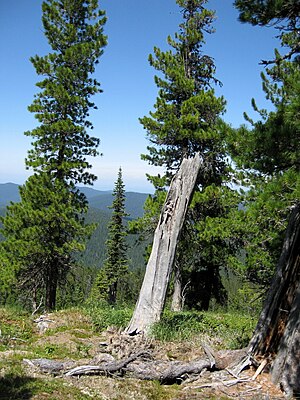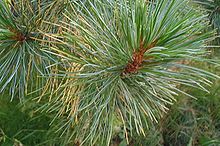Siberian stone pine
| Siberian stone pine | ||||||||||||
|---|---|---|---|---|---|---|---|---|---|---|---|---|

Siberian stone pine ( Pinus sibirica ) |
||||||||||||
| Systematics | ||||||||||||
|
||||||||||||
| Scientific name | ||||||||||||
| Pinus sibirica | ||||||||||||
| You tour |
The Siberian stone pine ( Pinus sibirica ) is a type of tree from the genus of pine ( Pinus ) within the pine family (Pinaceae). She is considered by many authors as subspecies or as a variety of stone pine ( Pinus cembra out).
description
The Siberian stone pine, also called Siberian cedar, is an evergreen tree that can grow up to 40 meters high in suitable locations. It forms a deep crown , with various reports about the branching. Trees growing near the city of Perm are said to have 20 to 25 meters long, knot-free trunks. There is no cleaning of branches on wet locations and the trunks are usually bulging. The color and structure of the bark are subject to great variation, which is particularly pronounced on the southern border of the natural distribution area. It is the same with the size, color and shape of the cones . The cones are longer and more cylindrical than those of the Swiss stone pine . The seeds are larger and have a thinner shell.
The number of chromosomes is 2n = 24.
Distribution and location
The distribution area is between 50th and 68th degrees north latitude. The northern border is in the West Siberian lowlands near Salekhard , the south-western border in the Urals lies in the Sverdlovsk Oblast between the Chusovaya and Ufa rivers . The main distribution area is in Siberia and extends from the Urals to the Altai and the Sajan Mountains with the upper reaches of the Ob , Yenisei and Lena rivers . In the Altai Mountains it forms the tree line. They are found at altitudes from 100 to 2,580 meters. Forest additions are rarely made.
The Siberian stone pine mostly forms pure stands. It makes little demands on the soil and occurs on gravel , dry slopes, alluvial valley floors and in moors . The species is tolerant of oxygen-poor soils.
Diseases and pests
The Siberian stone pine is highly susceptible to the pathogen of Strobenrostes , Cronartium ribicola . The pathogen was introduced to America with plants of this type at the turn of the 19th and 20th centuries. The species is often attacked by the root sponge ( Heterobasidion annosum ), which also causes severe damage. Stick rot is also common .
use
The wood of the Siberian stone pine is used as tonewood and in pulp production using the sulphate process . The abbreviation as commercial wood according to DIN EN 13556 is PNSB, the corresponding German standard wood name Siberian pine.
The Siberian stone pine is also used to create windbreak strips, whereby the use of the seeds plays a role. The seeds (the so-called "cedar nuts") contain an average of 59.9% fat, 16.6% protein and 12.4% carbohydrates. The so-called cedar nut oil , which is used as an edible oil, can be obtained from them .
Systematics
The species status of the Siberian stone pine is controversial. It is considered by some authors as a subspecies or a variety of the stone pine ( Pinus cembra ). The Siberian stone pine was identified as a species by Du Tour 1803 in the work of J.-F.-P. Déterville "Nouveau Dictionnaire d'histoire naturelle appliqué aux arts ..", Volume 18, Page 18 first described.
Synonyms
The following synonyms are known for the Siberian stone pine: Pinus cembra subsp. sibirica (Du Tour) Krylow , Pinus cembra var. sibirica (Du Tour) G.Don , Pinus coronans Litv. or Pinus arolla Petrov .
literature
- Schütt, Weisgerber, Schuck, Lang, Stimm, Roloff: Lexicon of Conifers . Nikol, Hamburg 2008, ISBN 3-933203-80-5 , p. 345-355 . (the first part of the description is about the stone pine)
Individual evidence
- ^ Tropicos. [1]
- ↑ a b Rafaël Govaerts (Ed.): Pinus. In: World Checklist of Selected Plant Families (WCSP) - The Board of Trustees of the Royal Botanic Gardens, Kew . Retrieved April 25, 2019.
Web links
- Pinus sibirica inthe IUCN 2013 Red List of Threatened Species . Posted by: Farjon, A., 2011. Retrieved October 1, 2013.



